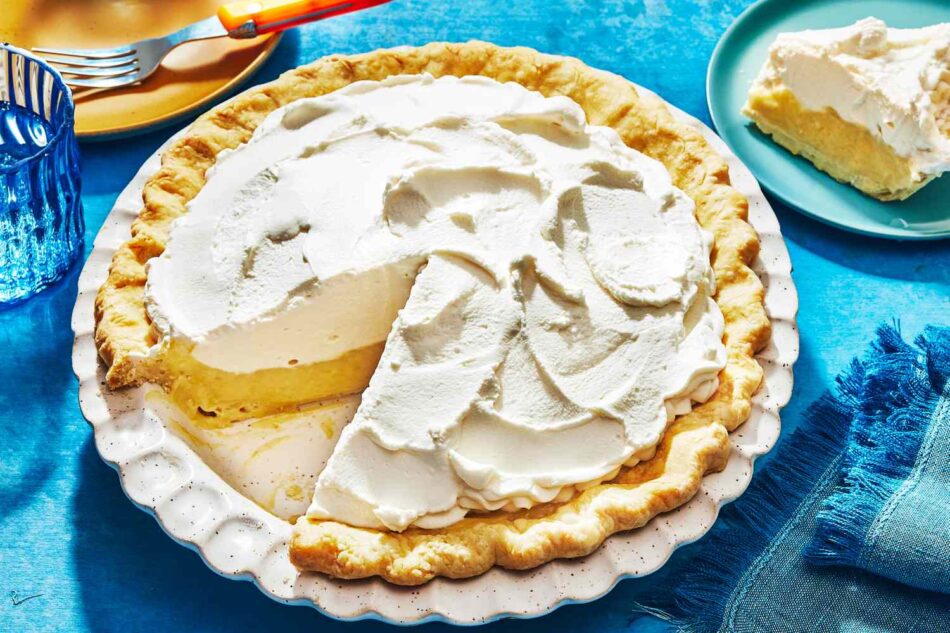Every year in the early fall, along the riverbanks and ravines of the Southeast coast, pawpaws begin to show up in the understory. Mysterious and musky, they dangle, waiting to be discovered.
North America’s largest native edible fruit, pawpaws are abundant in the wild but a rare sight in grocery stores, so if you want them, you need to be a forager or a friend of one. I started out as the latter, but as I’ve grown to love these tropical-tasting fruits over the years, I’ve become the former, training my eye on the trees that surround the James River, hoping to spot them and take a few home.
When I do, I like to use their sweet, custardy pulp in a classic cream pie. Pawpaws have a hard-to-place, unique flavor that gives notes of banana and mango, as well as a third, more mysterious thing. They can be extremely sweet or a bit tannic, depending on the exact variety and the ripeness of the fruit. They’re highly perishable and a little fiddly to work with, due to the large inedible seeds that they’re full of. But worked into a pastry cream filling, the sweet, honeyed flavor blooms beautifully to create something thrilling and memorable.
Ingredients for Pawpaw Cream Pie
- Pie crust: The home for your pawpaw-flavored pastry cream is a flaky, pre-baked pie crust.
- Heavy cream: This cream pie is topped with whipped cream for an extra layer of creamy sweetness.
- Vanilla extract: Vanilla flavors the whipped cream and helps amplify the pawpaw in the pastry cream.
- Powdered sugar: Powdered sugar is the best choice for sweetening the whipped cream because it melts into the cream easily.
- Eggs and egg yolk: The combination of whole eggs and egg yolks gives the pastry cream its structure and richness.
- Cornstarch: Cornstarch does the work of thickening the pastry cream to the perfect consistency.
- Granulated sugar: Used to sweeten the pastry cream, granulated sugar gets dissolved into the heated milk.
- Whole milk: In combination with the eggs, whole milk gives pastry cream the necessary dairy fat to create a smooth, creamy consistency.
- Unsalted butter: A bit of butter, added at the end, gives pastry cream a nice shine and additional richness.
- Pawpaw pulp: The star of the show, or pie in this case, pawpaw pulp sweetens and flavors the pastry cream, giving it a slightly tropical, decidedly unique flavor profile.
Foraging for Pawpaws
Finding pawpaws feels a bit like finding hidden treasure. Here in Virginia, I find them in the tree canopy along the banks of the James River. Look for the large, tear drop-shaped leaves and the slender, grey tree trunks.
You can often find clusters of pawpaw trees in one spot. The fallen fruit is typically ripe, but I’ve also been known to climb trees (and in one case, throw my shoe) to get the fruit to fall.
Cooking With Pawpaws
- Pawpaws are covered by a thin skin. Inside, you’ll find a soft flesh, similar in both texture and taste to a mix between banana and honey mangoes. They are riddled with large, dark brown inedible seeds, and the pulp must be removed from the seeds to be used.
- To remove the pulp from the seeds, use a spoon or butter knife to scrape the pulp, separating it from the seeds, which may be discarded. Mash the pulp with a fork for a more rustic texture, or puree further in a food processor or blender before adding to recipes.
- Pawpaws tend to ripen quickly, so once you have a ripe pawpaw, go ahead and harvest the pulp. It should last for a couple of days, tightly sealed, in the refrigerator; or you can freeze the pulp for up to two months.
How To Store Leftover Pawpaw Cream Pie
Once assembled, Pawpaw Cream Pie can be refrigerated, covered, for up to five days.
NEVER LOSE A FAVORITE RECIPE AGAIN
With MyRecipes, your personal recipe box, you can save and organize your Southern Living favorites and thousands more in one place.







